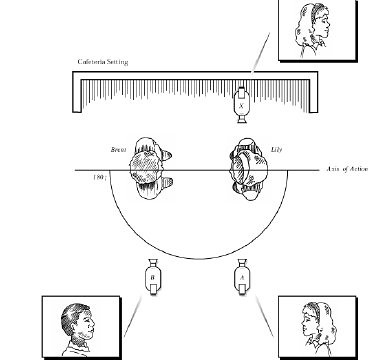Editing is the creative force of filmic reality...and the foundation of film art.V.I. Pudovkin, 1915
After the completion of filming, the final stage is film editing - the selection and piecing together of shots to form the completed film. Just as a range of choices exists for the cinematographer when manipulating light and using a camera, so editing offers many possibilities.
Continuity Editing
One of the key principle is continuity editing. Most films, in one way or another, attempt to have us fully engrossed in what we see. The intention is that we escape into the film for the duration of the screening. The concept of ‘willing suspension of disbelief ‘sums up the experience of much film-going. We know that what we see on the screen isn’t real, in other words, we disbelieve it, but in order to fully engage with the film we willingly suspend that disbelief – we happily ignore our doubts about the authenticity of what we see. We allow ourselves to enter the world (the digenesis) of the film.

In order that we can experience films this way, it is important that we are not reminded that we are watching a film and that we are not confused by an incomprehensible presentation of events in the narrative. Annette Kuhn writes: ‘Continuity editing establishes spatial and temporal relationships between shots in such a way as to permit the spectator to “read” a film without any conscious effort, precisely because the editing is “invisible”, (in Cook and Bernink, 1999, p.40). For this to be possible, it is essential that the shots flow smoothly from one to another and that our attention is not drawn to the edit points. In effect, the shots support each other. One shot logically leads to the next and to a degree we expect the next shot: there is continuity between one shot and the next. A number of techniques help make this possible.
Movement and Speed of Editing
To ensure such ‘transparent’ editing, it is necessary that the locations, props, actors and movement in one shot are consistent with what has gone before. The speed at which some thing happens and the space within which it occurs should be consistent across the relevant shots. In effect, continuity editing supports the meanings produced by the audio/visual interpretations of the narrative.
This principle can be illustrated by reference to a scene mentioned previously, the climactic moment in Cinema Paradiso when Salvatore rescues Alfredo from the fire that has started in the cinema projection room. The pace of editing is fast, people are panicking, events move with speed. Within this scene there is a consistency with regard to time and movement and similarly there is a consistency in the locations and space within which the events unravel. Failure to maintain this consistency would interrupt our involvement in the film and draw attention to the artificial and constructed nature of film.
Shot /Reverse Shot Editing
Film Editing also helps to clarify situations by joining together shots from different angles to provide us with different perspectives, thereby creating a fuller understanding. This is common during conversations where a shot/reverse shot edit is frequently used. The shots themselves are often over the shoulder shots in which we see part of the back of one person’s head and shoulders and the front of the other person talking to them. The editing provides an understanding of the spatial relationship between the characters while also giving information on movement and facial expression.

This particular scene also serves to illustrate another common principle behind editing, the use of a variety of shot sizes. On one level a variety of shot sizes helps maintain our interest visually through avoiding repetition, but it also serves another function. We have already noted the various meanings that shot sizes can produce, and through editing a logical progression is created out of shot size. In the scene from the above example we are provided with an extreme long shot of the village and cinema to provide context. The shots are then edited together to eventually take us onto a more personal level as we see Salvatore in extreme close up battling his way through the crowds to Alfredo.
End of post. Film Editing shall be continued in the next one
1 comment:
Thanks for the advice on where to point the camera for the editing process.
Post a Comment